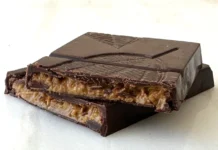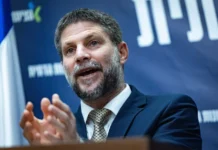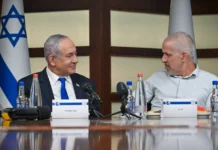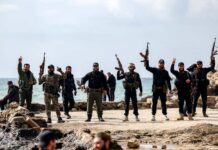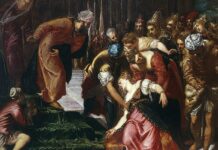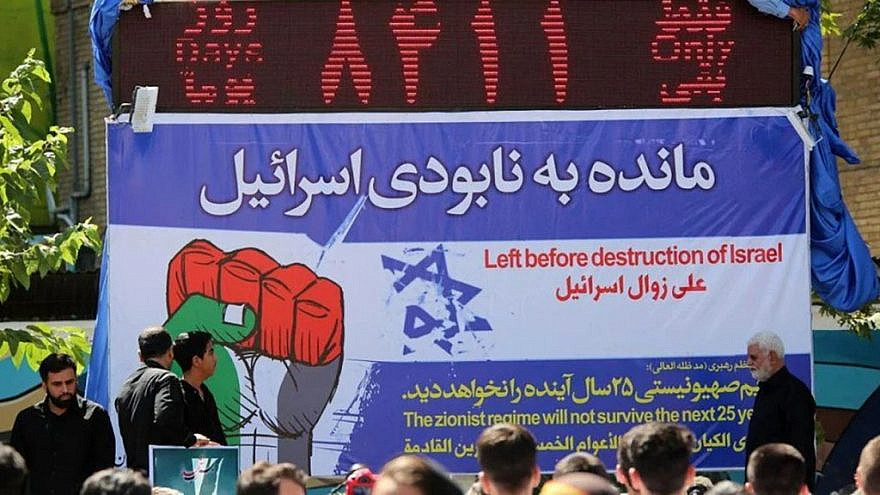Iran is once again trying to leverage the latest round of escalation in Jerusalem, and present itself as the main power fighting for the Palestinians, in particular, and the Muslim nation, in general. Events in Jerusalem—the disturbances at the Al-Aqsa mosque and tensions in Sheikh Jarrah—corresponded this year with the Iranian International Quds Day.
This day has been marked every year by the Iranian government since 1979—through a decision of Ayatollah Khomeini, founder of the Iranian revolution—to signify the “longing” of all Muslims for the “liberation of Jerusalem” and the “restoration of the legitimate rights of the Palestinians in Palestine.” Iranian media is giving full coverage to the clashes on the Temple Mount and the ongoing rocket fire on Israel by the “Resistance Organizations.”
A poster and statement issued by Supreme Leader Ali Khamenei’s office clearly illustrate the changing balances of power. In Tehran’s view, the Palestinians have progressed from stones to missiles (displayed alongside the Palestinian resistance and Hezbollah’s flag in the background).
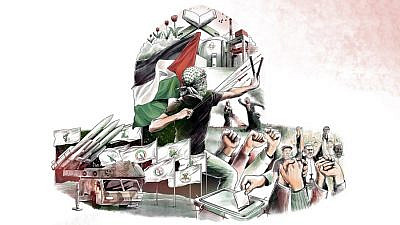
Khamenei praises the unity of the Muslim nation, and above all, the Iranian nuclear power that provides—and will provide—the strategic blanket to enable continued terror and subversive activity.
The poster, based on the main points of Khamenei’s speech on Al-Quds Day, reads: “Today, the world is changing. We must always remember this fact. Today, the balance of power has shifted in favor of the Muslim world … The growth of resistance forces in the most sensitive Islamic areas, strengthening their defensive and attack capabilities, increasing self-awareness and motivation and hope among the Nations of Islam, growth in Islamic understanding and refrains, scientific growth, growth in the desire for independence and nations’ self-reliance. These are all welcome signs that herald a better future.”
Khamenei: The strengthening of the jihad and sacrifice inclination
In his Al-Quds Day speech this year, the Iranian Leader reiterated, “The issue of Palestine continues to be the most important and dynamic one for the Islamic nation and the cooperation between Muslims around the axis of Jerusalem is a nightmare for the Zionists, Americans and Europeans who have been blindly supporting them for 70 years.”
Khamenei scoffed at the failure of [former U.S. President Donald Trump’s] “deal of the century,” and called the effort “by some weak Arab governments to normalize relations with Israel as a desperate attempt to escape this nightmare whose ends—I can promise—will fail.”
Khamenei said that “the Zionist enemy is already in the process of a never-ending collapse.” He speculated in this context that two main forces are dictating what will come: the first and most important is “the continued active resistance of the Palestinian people on the land of Palestine with the strengthening of the trend of jihad and self-sacrifice. The second force is the global support for the Palestinians by the Islamic governments around the world.”
Khamenei added that today, “the hope of achieving victory is stronger than ever since one side of the scale has begun to rise in favor of the Palestinians and the Islamic world … with the Zionist enemy weakening from year to year, the split in Europe and the results of the U.S. elections.”
Compare that to the increased power of Muslims, said Khamenei. The ability and independence of Muslims in the area of defense and attack (hinting at Iranian capability) has grown and “heralds a better future for the Islamic nation.”
In his speech, Khamenei stated that Israel is not a country, but rather a terrorist camp against the Palestinian and other Muslim nations. Fighting against this despotic regime is fighting against oppression and terrorism. And this is a collective responsibility.”
He called for unity of all Muslim countries and said that Muslim and Christian clerics should declare that normalization with Israel is religiously forbidden (haram).”
‘The Supreme Leader’s predictions of Israel’s disappearance within 25 years will come true’
Other Iranian spokesmen from the Islamic Revolutionary Guard Corps and the military followed the Iranian leader. The army’s commander-in-chief, Maj. Gen. Abdulrahim Mousavi, declared, “The signs of the collapse of the [Israeli] regime have been realized,” and the “balance of forces now tilts toward the Palestinians.” He repeated the Supreme Leader’s prediction that Israel will not exist in 25 years.
Ali Akbar Velayati, Iran’s former foreign minister and Khamenei’s adviser on international affairs, also serves as head of the World Assembly of Islamic Awakening. He said that the Palestinian issue was the top priority of Iranian foreign policy, and that it was also supporting our “Palestinian brothers” not only in the political sphere but also on the operational and resistance level “until the liberation of Al-Quds from the occupation.”
He added that today, in light of the strategic security aspects of the armed conflict by the resistance front against Israel, the survival of the Zionist regime faces a very great domestic danger. Velayati noted that “the recent defeats of the Zionist regime in Lebanon and Gaza, as well as in Syria, accurately reflect the predictions of Iranian leader Khamenei (made in 2015) that Israel will not live on for another 25 years.”
Khomeini’s legacy: The elimination of Zionism is a necessary condition
The teachings of Khomeini (“The elimination of Zionism is an almost necessary condition for solving the problems of Islam today”), which are repeated, in general, and on Al-Quds Day, in particular, continue to serve as the anchor that dictates, defines, nourishes and shapes the objectives of the Islamic revolution, including the annual call for the elimination of the “Zionist entity.”
His words, repeated every year by regime officials, continue to echo and guide the second and third generations of the revolution. They are a kind of “perennial mantra” that cannot be deviated from, challenged or disputed, and they must be constantly and actively repeated in order to actualize them.
International Quds Day has since become a central anchor in the Islamic regime’s calendar, and it is planned much in advance in Iran and areas of (mainly Shi’ite) Muslim concentration abroad. One of the most prominent characteristics is mass “Death to Israel” and “Death to the United-States” marches (usually following the recruitment and organized transportation by the regime and its affiliates).
The Soleimani myth
This year, too, International Quds Day was associated with the mythical image of IRGC Quds Force commander Gen. Qasem Soleimani. As part of Soleimani’s glorification after his assassination, and his beatification as an integral part of Shi’ite mythology, the Iranian military leader is likened to Malik al-Ashtar, one of the closest loyalists to the founder of Shi’ite Islam, Imam Ali ibn Abi Talib (Imam Hasan’s father). Al-Ashtar fought in legendary battles at the beginning of Islam (the Battles of the Camel, Siffin and Yarmuk), and was seen as a trained and fearless fighter.
The picture of Soleimani’s amputated hand wearing his ring is distributed widely on social media and has become one of the symbols of his assassination and the continuation of the struggle against Israel. The ring has great significance in the iconography of Shi’ite believers, and is associated with the legends of battles (mainly Karbala) and historical Shi’ite sacrifice.
Iran is trying to present Soleimani as the symbol of international and regional struggles, and in this context, also to the ongoing struggle of the Palestinians, Hezbollah, the Shi’ite militias in Iraq and the Houthis in Yemen. Iran seeks to prove that it is possible to fight regional enemies, supported by the United States, and especially Israel
As a tribute to Soleimani’s legacy and reflecting Iran’s tight grip over Islamic Jihad, the terror organization named one of its rockets “Qasem” after Soleimani. They claim that they fired it against Israel during the latest operation.
Soleimani’s successor, Gen. Esmail Ghaani, held a telephone conversation with Ismail Haniyeh, head of the Hamas political bureau, and Ziyad al Nakhalah, Islamic Jihad’s secretary-general, to reassure them of Iran’s continued support for the Palestinian nation and the “resistance against the Zionist enemy and its relentless acts of aggression against Jerusalem (Al-Quds) and the Gaza Strip.”
Haniyeh praised Iran’s support for the Palestinian nation and conveyed his gratitude to Khamenei in a telephone conversation with Ali Akbar Velayati, who expressed hope that “soon, after victory,” Haniyeh will meet Khamenei in person in Iran.
In this context, Foreign Minister Mohammad Javad Zarif’s leaked tape, which caused outrage in Iran and beyond, reflected the decisive priority given by Khamenei to the subversive activity carried out by the Quds Force in the region over Zarif’s Foreign Ministry diplomacy and Iran’s integration into the region. The Supreme Leader is aware of the political and economic cost that Iran is willing to pay (and actually pays) for promoting and adhering to the implementation of its ideological objectives.
Slogans adapted to the changing reality
There was little new in this year’s blatant anti-Israeli, anti-Zionist, and anti-Western (“Death to America”) rhetoric of the Iranian leader, the heads of the regime and the IRGC. They echo the original revolutionary slogans, pour them into the spirit of time and place and link them to the new geostrategic reality in the region in particular (the peace agreements with the “weak Gulf states” and tensions in Jerusalem).
They stir that into the situation around the world in general (the departure of the Trump administration, which is seen as another sign of divine intervention in favor of Iran and Muslims), and the founding ideas that guide Iran’s hostility and suspicion of the West (especially the United States, even after the restart of the Vienna talks) and Israel (“planted by the West in this sensitive Islamic region”).
Khomeini’s activist interpretation of Shi’ite Islam and the revolution in Shi’ism that he led are constantly being validated and connecting, especially for Iran’s current leaders, even in their difficult times, between successes in the Iranian-national dimension (confronting sanctions, surviving the Trump administration, maintaining an active military nuclear program, overthrowing Saddam Hussein and the resuscitation of the Shi’ites in Iraq, “the victories” of the Palestinian organizations and Hezbollah over Israel (with Iran’s support), and the religious dimension (the “Mahdi hand” and divine intervention). All of these strengthen and shape the inner belief and persuasion on the righteousness of their path and the rationale to demonstrate resilience and continue the resistance.
This is what Iran believes is the fulfillment of Khomeini’s previous “prophecies” about the collapse of the Soviet Union (Communism) and Saddam’s fall; his prophecy of the destruction of Israel will eventually be fulfilled, and Iran has the power to bring it about.
Activist approach
In the complex fabric (according to the Zarif tapes) of exporting the revolution and promoting the revolutionary aspirations of the Islamic regime, the annual reverberation of the call for the elimination of the State of Israel (the “Zionist regime,” “the Zionist entity” and “the regime occupying Al-Quds”) is an opportunity for Iran to demonstrate an activist approach to “the liberation of Palestine and Al-Quds.”
In the face of what Tehran defines as the irresponsibility of Sunni-Arab leaders, who are normalizing relations with Israel and thus betraying the Palestinians, Khamenei stressed that Iran is arming Hamas and Islamic Jihad in Gaza, and allowing them to strike a balance in the armed struggle against Israel. Khamenei has also previously called for arming the Palestinians in Judea and Samaria.
In that context, a cartoon appeared on the front page of Khamenei’s homepage, with the inscription “Rock to Missile,” indicating Iran’s role in shifting the equations of power in the region. The cartoon features Handala, a famous cartoon figure of the Palestinian cartoonist Naji al-Ali.
In the past, Iran tried to wrap the extremist ideological messages in a ribbon. Today, the messages are more blatant and direct, in the spirit of the “Final Solution,” which was the Supreme Leader’s motto on last year’s Quds Day.
The Iranian regime is not expected to change its ideological positions regarding its perception of the State of Israel as a foreign weed and “cancerous tumor.” Iran will continue to market these themes more strongly in the region, adapting them to the changing reality and circumstances in the international arena.
Last year, in the face of Trump’s “deal of the century” initiative, Iran presented the “Iranian peace plan,” entitled “The Final Solution to the Problem of Palestine: Referendum,” which actually meant the elimination of the State of Israel as a Jewish state. This year is presented as another stage in Israel’s collapse, as opposed to Iran’s successes in resisting American pressure and surviving Trump’s administration.
Calls for Israel’s destruction and “death to the United States” will continue to reverberate around the world next year, and Iran will continue to simultaneously advance its strategy for obtaining nuclear weapons. During Jerusalem Day in 2005, then-President Mahmoud Ahmadinejad called on the Palestinians to “hold on wisely for a short time, and if we successfully go through it, the process of destroying the Zionist regime will be simple and short.”
Iran, Gaza and Vienna
If Iran manages during the current talks in Vienna to remove from the Joint Comprehensive Plan of Action talks the issue of its adverse activity, subversion in the region and ballistic missiles, the Iranian regime will celebrate a significant achievement. At the moment, the Americans are calling for a “longer and stronger agreement, but it seems that, in the end, these issues are doomed to remain outside the renewed JCPOA.
Therefore, precisely against the backdrop of the continued fighting in Gaza and Yemen, Iran’s role in supplying rockets and know-how for their production, and training Hamas, PIJ and Houthi operatives in operating them, it is critical to insist on highlighting Iran’s involvement in regional conflicts and their devastating results in fueling and prolonging those conflicts.
If the U.S. returns to the nuclear deal under Iran’s dictates and removes an essential sanction—or all sanctions—Iran will take advantage of such a gesture. The Islamic Republic will inject additional resources into its subversive and terrorist activities in the region, in particular, and around the world (including along American borders), in general, in a renewed and well-funded attempt to reshape the Middle East, while the U.S. is reducing its presence and interest in the region.
In this context, what is required in Vienna is a determined American and European position vis-à-vis Iran and insistence on raising the problematic Iranian conduct on issues of subversion, missiles and human rights. It should be emphasized again that Iran, which operates mainly to achieve ideological goals, assisted the elements of the Axis of Resistance even during the harshest sanctions against it and domestic protest. Even if some of the sanctions were lifted, it would make it easier for Iran to export the revolution, despite steady domestic pressure.
For Iran, investing in the “Axis of Resistance” throughout the region is an important pillar of its national security strategy. Gen. Ali Asghar Emami, one Quds Force commander, declared: “Through our presence in the Axis of Resistance, we have placed you (Israel) under siege … with our presence in the Resistance Axis, we can hit Israel with mortar shells. Whenever we want, whenever the leader wants and gives the order, we can easily plough the cities of the Zionist regime, (and since) the Zionist regime is the center of America, we have [America] under siege. Whenever we want to strangle America, to exert pressure on it, extract concessions from it, and get what we deserve, we can easily tighten our grip around the throat of the Zionist regime, because it is surrounded from all directions.”
IDF Lt. Col. (ret.) Michael (Mickey) Segall, an expert on strategic issues with a focus on Iran, terrorism and the Middle East, is a senior analyst at the Jerusalem Center for Public Affairs and at Alcyon Risk Advisors.
This article was first published by the Jerusalem Center for Public Affairs.

